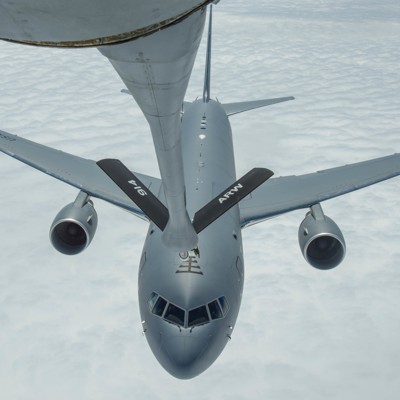ROYAL AIR FORCE FAIRFORD, England—After years of uncertainty about the Air Force’s tanker plans, the service has decided to buy more KC-46s instead of launching a new competition for its next tanker buy.
This decision ends speculation that the service might launch a contest, likely between Boeing and Airbus, for an interim tanker buy of 75 aircraft to replace the aging KC-135 fleet. Instead, the Air Force will purchase more of the troubled but already-in-production KC-46 as a “bridge” solution until it figures out its long-term tanking needs.
“The Air Force approved the acquisition strategy for the KC-46 extension program. That acquisition strategy approves up to 75 additional KC-46s. Now, there are obviously details to be worked out in the pricing and all the management there, but the acquisition strategy has been approved for up to 75 KC-46s in the KC-46 extension plan as part of KC-135 recapitalization,” Air Force Chief Gen. David Allvin told Defense One on the sidelines of the Royal International Air Tattoo.
The decision to stick with Boeing’s KC-46 likely stems from budget pressures, since continuing Pegasus production would cost less than putting research and development money into a new program. The new contract will come after Boeing finishes delivering tankers under the current program of record, for 188 aircraft.
While a strategy has been approved, the Air Force stressed that details like contract type and cost still need to be worked out. Boeing has been building the KC-46 under a fixed-price contract, which has resulted in billions of dollars in losses for the company. If the service changes the current contract, it could move some parts of the program—such as needed fixes or upgrades to the tanker—to a cost-plus arrangement, under which Boeing would be reimbursed for work.
The decision to buy additional KC-46s was looking more and more likely after the service included funds for a “Tanker Production Extension” program in its 2026 budget request. That program would use the KC-46 as “the most affordable requirements basis” for the extension effort, according to budget documents.
For two decades, the Air Force had planned to build its tanker fleet under a three-pronged plan: buy a commercial modified tanker, launch a competition for another commercial modified tanker to be the “bridge buy,” and eventually build a next-generation aircraft. The first step of the plan was the KC-46.
Then, in 2023, service officials announced they would cut the second part of the plan— the bridge tanker buy—down from 160 to 75 aircraft, and accelerate the next-gen tanker program, called “Next Generation Air Refueling System.”
The service had once hoped to field the stealthy new tanker by the end of the 2030s, but that timeline looks increasingly unlikely, since the Air Force cut NGAS funding down to $13 million in the 2026 budget request and has instead focused its attention on the sixth-gen fighter program, the F-47.
Allvin stressed that NGAS is not one platform, but rather a family of systems that may or may not include a brand-new tanker. And, he said, some of the funds in the 2026 NGAS budget line will go to look at how the service can make its current tankers more survivable.
Meanwhile, the Air Force continues to work through problems with the KC-46 program, which has been plagued by a number of “category one” deficiencies—problems with the potential to cause a crash or loss of life—and delivery pauses.
Allvin said he’s “comfortable” with Boeing’s progress on the deficiencies, and that the tanker is still functioning “very well” in operations, referring to the tanker’s role in Operation Midnight Hammer, where KC-46s helped refuel B-2s that struck Iran’s nuclear development sites in June.
“I’m not saying we’re totally out of the woods, but I believe we are making good progress clearing those deficiencies, and the aircraft is performing very well operationally,” Allvin said.
